Exchange Currency
British pound
The pound sterling, commonly called the pound, is the official currency of the United Kingdom, its Crown Dependencies and the British Overseas Territories of South Georgia and the South Sandwich Islands, British Antarctic Territory and Tristan da Cunha. It is subdivided into 100 pence (singular: penny).
Pound sterling is the fourth most traded currency in the foreign exchange market, after the US dollar, the euro and the Japanese yen. Together with those three currencies it forms the basket of currencies which calculate the value of IMF Special Drawing Rights, with an 11.3% weighting as of 2011. Sterling is also the third most held reserve currency in global reserves.
The accounting system of 12 pence = 1 shilling, 20 shillings = 1 pound was adopted from that introduced by Charlemagne to the Frankish Empire.
The origins of sterling lie in the reign of King Offa of Mercia, (757–796) who introduced the silver penny. It copied the denarius of the new currency system of Charlemagne’s Frankish Empire. As in the Carolingian system, 240 pennies weighed 1 pound, with the shilling corresponding to Charlemagne’s solidus and equal to 12d. At the time of the penny’s introduction, it weighed 22.5 troy grains of fine silver, indicating that the Mercian pound weighed 5,400 troy grains. At this time, the name sterling had yet to be acquired. The penny swiftly spread throughout the other Anglo-Saxon kingdoms and became the standard coin of what was to become England.
The early pennies were struck from fine silver. However, in 1158, a new coinage was introduced by King Henry II which was struck from .925 (92.5%) silver. This became the standard until the 20th century and is today known as sterling silver, named after its association with the currency. Sterling silver is harder than the fine silver (i.e. 0.999/99.9% pure, etc.) that was traditionally used and so sterling silver coins did not wear down as rapidly as fine silver coins. The English currency was almost exclusively silver until 1344, when the gold noble was successfully introduced into circulation. However, silver remained the legal basis for sterling until 1816. In the reign of Henry IV (1399–1413), the penny was reduced in weight to 15 grains (0.97 g) of silver, with a further reduction to 12 grains (0.78 g) in 1464.
During the reigns of Henry VIII and Edward VI, the silver coinage was drastically debased, although the pound was redefined to the troy pound of 5,760 grains (373 g) in 1526. In 1544, a silver coinage was issued containing just one third silver and two thirds copper—equating to .333 silver, or 33.3% pure. The result was a coin copper in appearance, but relatively pale in color. In 1552, a new silver coinage was introduced, struck in sterling silver. However, the penny’s weight was reduced to 8 grains (0.52 g), meaning that 1 troy pound of sterling silver produced 60 shillings of coins. This silver standard was known as the «60-shilling standard» and lasted until 1601 when a „62-shilling standard” was introduced, reducing the penny’s weight to 7 23⁄31 grains (0.50 g). Throughout this period, the size and value of the gold coinage fluctuated considerably.
In 1663, a new gold coinage was introduced based on the 22 carat fine guinea. Fixed in weight at 44½ to the troy pound from 1670, this coin’s value varied considerably until 1717, when it was fixed at 21 shillings (21/-, 1.05 pounds). However, despite the efforts of Sir Isaac Newton, Master of the Mint, to reduce the guinea’s value, this valuation overvalued gold relative to silver when compared to the valuations in other European countries. British merchants sent silver abroad in payments whilst goods for export were paid for with gold. As a consequence, silver flowed out of the country and gold flowed in, leading to a situation where Great Britain was effectively on a gold standard. In addition, a chronic shortage of silver coins developed. The Bank of England was formed in 1694, followed by the Bank of Scotland a year later. Both began to issue paper money.
The pound scots had begun equal to sterling but had suffered far higher devaluation until being pegged to sterling at a value of 12 pounds scots = 1 pound sterling. In 1707, the Kingdom of England and the Kingdom of Scotland merged to form the Kingdom of Great Britain. In accordance with the Treaty of Union, the currency of the „united kingdom” was sterling with the pound scots being replaced by sterling at the pegged value.
During the Revolutionary and Napoleonic wars, Bank of England notes were legal tender and their value floated relative to gold. The Bank also issued silver tokens to alleviate the shortage of silver coins. In 1816, the gold standard was adopted officially, with the silver standard reduced to 66 shillings (66/-, 3.3 pounds), rendering silver coins a "token" issue (i.e., not containing their value in precious metal). In 1817, the sovereign was introduced, valued at 20 shillings. Struck in 22-carat gold, it contained 113 grains (7.3 g) of gold and replaced the guinea as the standard British gold coin without changing the gold standard. In 1825, the Irish pound, which had been pegged to sterling since 1801 at a rate of 13 Irish pounds = 12 pounds sterling, was replaced, at the same rate, with sterling.
During the late 19th and early 20th centuries, many other countries adopted the gold standard. As a consequence, conversion rates between different currencies could be determined simply from the respective gold standards. The pound sterling was equal to 4.85 U.S. dollars, 4.89 Canadian dollars, 12.10 Dutch guilders, 25.22 French francs (or equivalent currencies in the Latin Monetary Union), 20.43 German Marks or 24.02 Austro-Hungarian Krones. Discussions took place following the International Monetary Conference of 1867 in Paris concerning the possibility of the UK joining the Latin Monetary Union, and a Royal Commission on International Coinage examined the issues, resulting in a decision against joining monetary union.
The gold standard was suspended at the outbreak of the war in 1914, with Bank of England and Treasury notes becoming legal tender. Prior to World War I, the United Kingdom had one of the world’s strongest economies, holding 40% of the world’s overseas investments. However, by the end of the war the country owed £850 million (£30.7 billion as of 2011)., mostly to the United States, with interest costing the country some 40% of all government spending. In an attempt to resume stability, a variation on the gold standard was reintroduced in 1925, under which the currency was fixed to gold at its pre-war peg, although people were only able to exchange their currency for gold bullion, rather than for coins. This was abandoned on 21 September 1931, during the Great Depression, and sterling suffered an initial devaluation of some 25%.
Sterling circulated in much of the British Empire. In some parts, it was used alongside local currencies. For example, the gold sovereign was legal tender in Canada despite the use of the Canadian dollar. Several colonies and dominions adopted the pound as their own currency. These included Australia, Barbados, British West Africa, Cyprus, Fiji, Irish Free State, Jamaica, New Zealand, South Africa and Southern Rhodesia. Some of these retained parity with sterling throughout their existence (e.g. the South African pound), whilst others deviated from parity after the end of the gold standard (e.g. the Australian pound). These currencies and others tied to sterling constituted the Sterling Area.
In 1940, an agreement with the U.S.A. pegged the pound to the U.S. dollar at a rate of £1 = $4.03. This rate was maintained through the Second World War and became part of the Bretton Woods system which governed post-war exchange rates. Under continuing economic pressure, and despite months of denials that it would do so, on 19 September 1949 the government devalued the pound by 30.5% to $2.80. The move prompted several other currencies to be devalued against the dollar.
In the mid-1960s, the pound came under renewed pressure since the exchange rate against the dollar was considered too high. In the summer of 1966, with the value of the pound falling in the currency markets, exchange controls were tightened by the Wilson government. Among the measures, tourists were banned from taking more than £50 out of the country, until the restriction was lifted in 1979. The pound was eventually devalued by 14.3% to $2.40 on 18 November 1967.
On 15 February 1971, the UK decimalised, replacing the shilling and penny with a single subdivision, the new penny. The word «new» was omitted from coins after 1981. With the breakdown of the Bretton Woods system, the pound floated from August 1971 onwards. It at first appreciated a little, rising to almost $2.65 in March 1972, from 2.42 when it had been fixed. The Sterling Area effectively ended at this time when the majority of its members also chose to float freely against the pound and the dollar.
James Callaghan came to power in 1976. He was immediately told the economy was facing huge problems, according to documents released in 2006 by the National Archives. The effects of the 1973 oil crisis were still being felt, with inflation rising to over 27% in 1975. Financial markets were beginning to believe the pound was overvalued and in April of that year The Wall Street Journal advised the sale of sterling investments in a story titled "Good-bye Great Britain". At the time the UK government was running a budget deficit and Labour’s strategy emphasized high public spending. Callaghan was told there were three possible outcomes: a disastrous free fall in Sterling, an internationally unacceptable siege economy or a deal with key allies to prop up the pound while painful economic reforms were put in place. The US government feared the crisis could endanger NATO and the EEC and in light of this the US Treasury set out to force domestic policy changes. In November 1976 the IMF announced the conditions for a loan, including deep cuts in public expenditure.
The Conservatives arrived in power in 1979, on a programme of fiscal austerity. Initially, the pound rocketed, moving above the $2.40 level, as interest rates rose in response to the monetarist policy of targeting money supply. The high exchange rate was widely blamed for the deep recession of 1981. Sterling fell sharply after 1980; at its lowest, the pound stood at just $1.03 in March 1985, before returning to the US$1.70 level in December 1989.
In 1988, Margaret Thatcher’s Chancellor of the Exchequer Nigel Lawson decided that the pound should «shadow» the West German Deutsche Mark, with the unintended result of a rapid rise in inflation as the economy boomed due to inappropriately low interest rates.
Following German re-unification in 1990, the reverse held true, as high borrowing costs to fund Eastern reconstruction, a need exacerbated by the political choice to make the ostmark equivalent to the deutschemark, meant rates in other countries shadowing the DM, especially the UK, were far too high relative to domestic circumstances, leading to a housing decline and recession.
The first decimal coins were circulated in 1968. These were the five pence (5p) and ten pence (10p), and had values of one shilling (1/-) and two shillings (2/-), respectively, under the pre-decimal £sd system. The decimal coins are minted in copper-plated steel (previously bronze), cupro-nickel and nickel-brass. The two-pound coin is bimetallic. The coins are discs, except for the twenty pence and fifty-pence pieces, both of which are heptagons of constant curvature. All the circulating coins have an effigy of Queen Elizabeth II on the obverse, and various national and regional designs, and the denomination, on the reverse. The circulating coins, excepting the two-pound coin, were redesigned in 2008, keeping the sizes and compositions unchanged, but introducing reverse designs that each depict a part of the Royal Shield of Arms and form the whole shield when they are placed together in the appropriate arrangement. The exception, the 2008 one-pound coin, depicts the entire shield of arms on the reverse. All current coins carry a Latin inscription whose full form is ELIZABETH II DEI GRATIA REGINA FIDEI DEFENSOR, meaning „Elizabeth II, by the grace of God, Queen and Defender of the Faith”.
In addition to the circulating coinage, the UK also mints commemorative decimal coins (crowns) in the denomination of five pounds (previously 25 p). Ceremonial Maundy money and bullion coinage of gold sovereigns, half sovereigns, and gold and silver Britannia coins are also produced. Some territories outside the United Kingdom, that use the pound sterling, produce their own coinage, with the same denominations and specifications as the UK coinage but local designs.
In the years just prior to decimalization, the circulating British coins were the half crown (2/6), two shillings or florin, shilling, sixpence (6d), threepence (3d), penny (1d) and halfpenny (½d). The farthing (¼d) had been withdrawn in 1960.
All modern coins feature a profile of the current monarch’s head. The direction in which they face changes with each successive monarch, a pattern that began with the Stuarts. For the Tudors and pre-Restoration Stuarts, both left and right-facing portrait images were minted within the reign of a single monarch. Medieval portrait images tended to be full face.
From a very early date, British coins have been inscribed with the name of the ruler of the kingdom in which they were produced, and a longer or shorter title, always in Latin; among the earliest distinctive English coins are the silver pennies of Offa of Mercia, which were inscribed with the legend OFFA REX „King Offa”. The English silver penny was derived from another silver coin, the sceat, of 20 troy grains weight, which was in general circulation in Europe during the Middle Ages. In the 12th century, Henry II established the Sterling Silver standard for English coinage, of 92.5% silver and 7.5% copper, replacing the earlier medieval use of fine silver. The coinage reform of 1816 set up a weight/value ratio and physical sizes for silver coins. Silver was eliminated in 1947, except for Maundy coinage.
The pound is the official currency of the United Kingdom and the Crown dependencies of Britain. Three British Overseas Territories also have currencies called pounds which are at par with the pound sterling.
In most countries of the world the issue of banknotes is handled exclusively by a single central bank or government, but in the United Kingdom seven retail banks have the right to print their own banknotes in addition to the Bank of England; sterling banknote issue is thus not automatically tied in with one national identity or the activity of the state. The arrangements in the UK are unusual but not unique, as a comparable system is used in Hong Kong, where three banks issue their own banknotes in addition to the Hong Kong government.
Pound sterling is the fourth most traded currency in the foreign exchange market, after the US dollar, the euro and the Japanese yen. Together with those three currencies it forms the basket of currencies which calculate the value of IMF Special Drawing Rights, with an 11.3% weighting as of 2011. Sterling is also the third most held reserve currency in global reserves.
Summary info
Summary information about Pound sterling- ISO 4217 Code:
- GBP
- Currency sign:
- £
- Country:
- United Kingdom
- Subunit:
- penny
- Coins:
- 1 penny, 2 pence, 5 pence, 10 pence, 20 pence, 25 pence, 50 pence, 1 pound sterling, 2 pounds sterling, 5 pounds sterling
- Banknotes:
- 5 pounds sterling, 10 pounds sterling, 20 pounds sterling, 50 pounds sterling
- Central bank:
- Bank of England
History
The pound sterling is the world’s oldest currency still in use. The pound was a unit of account in Anglo-Saxon England, equal to 240 silver pennies and equivalent to one pound weight of silver. It evolved into the modern British currency, the pound sterling.The accounting system of 12 pence = 1 shilling, 20 shillings = 1 pound was adopted from that introduced by Charlemagne to the Frankish Empire.
The origins of sterling lie in the reign of King Offa of Mercia, (757–796) who introduced the silver penny. It copied the denarius of the new currency system of Charlemagne’s Frankish Empire. As in the Carolingian system, 240 pennies weighed 1 pound, with the shilling corresponding to Charlemagne’s solidus and equal to 12d. At the time of the penny’s introduction, it weighed 22.5 troy grains of fine silver, indicating that the Mercian pound weighed 5,400 troy grains. At this time, the name sterling had yet to be acquired. The penny swiftly spread throughout the other Anglo-Saxon kingdoms and became the standard coin of what was to become England.
The early pennies were struck from fine silver. However, in 1158, a new coinage was introduced by King Henry II which was struck from .925 (92.5%) silver. This became the standard until the 20th century and is today known as sterling silver, named after its association with the currency. Sterling silver is harder than the fine silver (i.e. 0.999/99.9% pure, etc.) that was traditionally used and so sterling silver coins did not wear down as rapidly as fine silver coins. The English currency was almost exclusively silver until 1344, when the gold noble was successfully introduced into circulation. However, silver remained the legal basis for sterling until 1816. In the reign of Henry IV (1399–1413), the penny was reduced in weight to 15 grains (0.97 g) of silver, with a further reduction to 12 grains (0.78 g) in 1464.
During the reigns of Henry VIII and Edward VI, the silver coinage was drastically debased, although the pound was redefined to the troy pound of 5,760 grains (373 g) in 1526. In 1544, a silver coinage was issued containing just one third silver and two thirds copper—equating to .333 silver, or 33.3% pure. The result was a coin copper in appearance, but relatively pale in color. In 1552, a new silver coinage was introduced, struck in sterling silver. However, the penny’s weight was reduced to 8 grains (0.52 g), meaning that 1 troy pound of sterling silver produced 60 shillings of coins. This silver standard was known as the «60-shilling standard» and lasted until 1601 when a „62-shilling standard” was introduced, reducing the penny’s weight to 7 23⁄31 grains (0.50 g). Throughout this period, the size and value of the gold coinage fluctuated considerably.
In 1663, a new gold coinage was introduced based on the 22 carat fine guinea. Fixed in weight at 44½ to the troy pound from 1670, this coin’s value varied considerably until 1717, when it was fixed at 21 shillings (21/-, 1.05 pounds). However, despite the efforts of Sir Isaac Newton, Master of the Mint, to reduce the guinea’s value, this valuation overvalued gold relative to silver when compared to the valuations in other European countries. British merchants sent silver abroad in payments whilst goods for export were paid for with gold. As a consequence, silver flowed out of the country and gold flowed in, leading to a situation where Great Britain was effectively on a gold standard. In addition, a chronic shortage of silver coins developed. The Bank of England was formed in 1694, followed by the Bank of Scotland a year later. Both began to issue paper money.
The pound scots had begun equal to sterling but had suffered far higher devaluation until being pegged to sterling at a value of 12 pounds scots = 1 pound sterling. In 1707, the Kingdom of England and the Kingdom of Scotland merged to form the Kingdom of Great Britain. In accordance with the Treaty of Union, the currency of the „united kingdom” was sterling with the pound scots being replaced by sterling at the pegged value.
During the Revolutionary and Napoleonic wars, Bank of England notes were legal tender and their value floated relative to gold. The Bank also issued silver tokens to alleviate the shortage of silver coins. In 1816, the gold standard was adopted officially, with the silver standard reduced to 66 shillings (66/-, 3.3 pounds), rendering silver coins a "token" issue (i.e., not containing their value in precious metal). In 1817, the sovereign was introduced, valued at 20 shillings. Struck in 22-carat gold, it contained 113 grains (7.3 g) of gold and replaced the guinea as the standard British gold coin without changing the gold standard. In 1825, the Irish pound, which had been pegged to sterling since 1801 at a rate of 13 Irish pounds = 12 pounds sterling, was replaced, at the same rate, with sterling.
During the late 19th and early 20th centuries, many other countries adopted the gold standard. As a consequence, conversion rates between different currencies could be determined simply from the respective gold standards. The pound sterling was equal to 4.85 U.S. dollars, 4.89 Canadian dollars, 12.10 Dutch guilders, 25.22 French francs (or equivalent currencies in the Latin Monetary Union), 20.43 German Marks or 24.02 Austro-Hungarian Krones. Discussions took place following the International Monetary Conference of 1867 in Paris concerning the possibility of the UK joining the Latin Monetary Union, and a Royal Commission on International Coinage examined the issues, resulting in a decision against joining monetary union.
The gold standard was suspended at the outbreak of the war in 1914, with Bank of England and Treasury notes becoming legal tender. Prior to World War I, the United Kingdom had one of the world’s strongest economies, holding 40% of the world’s overseas investments. However, by the end of the war the country owed £850 million (£30.7 billion as of 2011)., mostly to the United States, with interest costing the country some 40% of all government spending. In an attempt to resume stability, a variation on the gold standard was reintroduced in 1925, under which the currency was fixed to gold at its pre-war peg, although people were only able to exchange their currency for gold bullion, rather than for coins. This was abandoned on 21 September 1931, during the Great Depression, and sterling suffered an initial devaluation of some 25%.
Sterling circulated in much of the British Empire. In some parts, it was used alongside local currencies. For example, the gold sovereign was legal tender in Canada despite the use of the Canadian dollar. Several colonies and dominions adopted the pound as their own currency. These included Australia, Barbados, British West Africa, Cyprus, Fiji, Irish Free State, Jamaica, New Zealand, South Africa and Southern Rhodesia. Some of these retained parity with sterling throughout their existence (e.g. the South African pound), whilst others deviated from parity after the end of the gold standard (e.g. the Australian pound). These currencies and others tied to sterling constituted the Sterling Area.
In 1940, an agreement with the U.S.A. pegged the pound to the U.S. dollar at a rate of £1 = $4.03. This rate was maintained through the Second World War and became part of the Bretton Woods system which governed post-war exchange rates. Under continuing economic pressure, and despite months of denials that it would do so, on 19 September 1949 the government devalued the pound by 30.5% to $2.80. The move prompted several other currencies to be devalued against the dollar.
In the mid-1960s, the pound came under renewed pressure since the exchange rate against the dollar was considered too high. In the summer of 1966, with the value of the pound falling in the currency markets, exchange controls were tightened by the Wilson government. Among the measures, tourists were banned from taking more than £50 out of the country, until the restriction was lifted in 1979. The pound was eventually devalued by 14.3% to $2.40 on 18 November 1967.
On 15 February 1971, the UK decimalised, replacing the shilling and penny with a single subdivision, the new penny. The word «new» was omitted from coins after 1981. With the breakdown of the Bretton Woods system, the pound floated from August 1971 onwards. It at first appreciated a little, rising to almost $2.65 in March 1972, from 2.42 when it had been fixed. The Sterling Area effectively ended at this time when the majority of its members also chose to float freely against the pound and the dollar.
James Callaghan came to power in 1976. He was immediately told the economy was facing huge problems, according to documents released in 2006 by the National Archives. The effects of the 1973 oil crisis were still being felt, with inflation rising to over 27% in 1975. Financial markets were beginning to believe the pound was overvalued and in April of that year The Wall Street Journal advised the sale of sterling investments in a story titled "Good-bye Great Britain". At the time the UK government was running a budget deficit and Labour’s strategy emphasized high public spending. Callaghan was told there were three possible outcomes: a disastrous free fall in Sterling, an internationally unacceptable siege economy or a deal with key allies to prop up the pound while painful economic reforms were put in place. The US government feared the crisis could endanger NATO and the EEC and in light of this the US Treasury set out to force domestic policy changes. In November 1976 the IMF announced the conditions for a loan, including deep cuts in public expenditure.
The Conservatives arrived in power in 1979, on a programme of fiscal austerity. Initially, the pound rocketed, moving above the $2.40 level, as interest rates rose in response to the monetarist policy of targeting money supply. The high exchange rate was widely blamed for the deep recession of 1981. Sterling fell sharply after 1980; at its lowest, the pound stood at just $1.03 in March 1985, before returning to the US$1.70 level in December 1989.
In 1988, Margaret Thatcher’s Chancellor of the Exchequer Nigel Lawson decided that the pound should «shadow» the West German Deutsche Mark, with the unintended result of a rapid rise in inflation as the economy boomed due to inappropriately low interest rates.
Following German re-unification in 1990, the reverse held true, as high borrowing costs to fund Eastern reconstruction, a need exacerbated by the political choice to make the ostmark equivalent to the deutschemark, meant rates in other countries shadowing the DM, especially the UK, were far too high relative to domestic circumstances, leading to a housing decline and recession.
Coins
The standard circulating coinage of the United Kingdom is denominated in pounds sterling, and, since the introduction of the two-pound coin in 1998, ranges in value from one penny to two pounds. Since decimalization, on 15 February 1971, the pound has been divided into 100 (new) pence. From the 16th century until decimalization, the pound was divided into 20 shillings, each of 12 (old) pence. British coins are minted by the Royal Mint in Llantrisant, Wales. The Royal Mint also commissions the coins’ designs. As of 30 March 2010, there are an estimated 28 billion coins circulating in the United Kingdom.The first decimal coins were circulated in 1968. These were the five pence (5p) and ten pence (10p), and had values of one shilling (1/-) and two shillings (2/-), respectively, under the pre-decimal £sd system. The decimal coins are minted in copper-plated steel (previously bronze), cupro-nickel and nickel-brass. The two-pound coin is bimetallic. The coins are discs, except for the twenty pence and fifty-pence pieces, both of which are heptagons of constant curvature. All the circulating coins have an effigy of Queen Elizabeth II on the obverse, and various national and regional designs, and the denomination, on the reverse. The circulating coins, excepting the two-pound coin, were redesigned in 2008, keeping the sizes and compositions unchanged, but introducing reverse designs that each depict a part of the Royal Shield of Arms and form the whole shield when they are placed together in the appropriate arrangement. The exception, the 2008 one-pound coin, depicts the entire shield of arms on the reverse. All current coins carry a Latin inscription whose full form is ELIZABETH II DEI GRATIA REGINA FIDEI DEFENSOR, meaning „Elizabeth II, by the grace of God, Queen and Defender of the Faith”.
In addition to the circulating coinage, the UK also mints commemorative decimal coins (crowns) in the denomination of five pounds (previously 25 p). Ceremonial Maundy money and bullion coinage of gold sovereigns, half sovereigns, and gold and silver Britannia coins are also produced. Some territories outside the United Kingdom, that use the pound sterling, produce their own coinage, with the same denominations and specifications as the UK coinage but local designs.
In the years just prior to decimalization, the circulating British coins were the half crown (2/6), two shillings or florin, shilling, sixpence (6d), threepence (3d), penny (1d) and halfpenny (½d). The farthing (¼d) had been withdrawn in 1960.
All modern coins feature a profile of the current monarch’s head. The direction in which they face changes with each successive monarch, a pattern that began with the Stuarts. For the Tudors and pre-Restoration Stuarts, both left and right-facing portrait images were minted within the reign of a single monarch. Medieval portrait images tended to be full face.
From a very early date, British coins have been inscribed with the name of the ruler of the kingdom in which they were produced, and a longer or shorter title, always in Latin; among the earliest distinctive English coins are the silver pennies of Offa of Mercia, which were inscribed with the legend OFFA REX „King Offa”. The English silver penny was derived from another silver coin, the sceat, of 20 troy grains weight, which was in general circulation in Europe during the Middle Ages. In the 12th century, Henry II established the Sterling Silver standard for English coinage, of 92.5% silver and 7.5% copper, replacing the earlier medieval use of fine silver. The coinage reform of 1816 set up a weight/value ratio and physical sizes for silver coins. Silver was eliminated in 1947, except for Maundy coinage.
Banknotes
Sterling banknotes are the banknotes in circulation in the British Islands (encompassing the United Kingdom and the British Crown dependencies), denominated in pounds sterling. One pound is equivalent to 100 pence.The pound is the official currency of the United Kingdom and the Crown dependencies of Britain. Three British Overseas Territories also have currencies called pounds which are at par with the pound sterling.
In most countries of the world the issue of banknotes is handled exclusively by a single central bank or government, but in the United Kingdom seven retail banks have the right to print their own banknotes in addition to the Bank of England; sterling banknote issue is thus not automatically tied in with one national identity or the activity of the state. The arrangements in the UK are unusual but not unique, as a comparable system is used in Hong Kong, where three banks issue their own banknotes in addition to the Hong Kong government.
GBP banknotes pictures gallery
| 5 Pounds sterling | |
|---|---|
| Banknote of 5 Pounds sterling has dimensions 135×70 mm and main colors are dim gray, cambridge blue, pale silver and pastel blue. | |
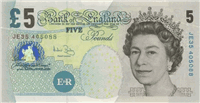 Obverse side of the 5 Pounds sterling is showing the portrait of Queen Elizabeth II. |
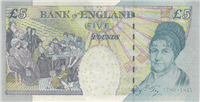 Reverse side of the 5 Pounds sterling is showing a portrait of Elizabeth Fry. |
| 10 Pounds sterling | |
|---|---|
| Banknote of 10 Pounds sterling has dimensions 142×75 mm and main colors are tan, dark tan, timberwolf, desert sand and platinum. | |
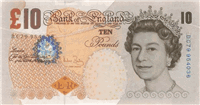 Obverse side of the 10 Pounds sterling is showing the portrait of Queen Elizabeth II. |
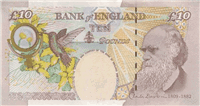 Reverse side of the 10 Pounds sterling is showing a portrait of Charles Darwin. |
| 20 Pounds sterling | |
|---|---|
| Banknote of 20 Pounds sterling has dimensions 149×80 mm and main colors are manatee, slate gray, pastel gray and pastel purple. | |
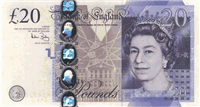 Obverse side of the 20 Pounds sterling is showing the portrait of Queen Elizabeth II. |
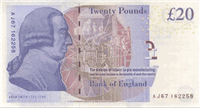 Reverse side of the 20 Pounds sterling is showing a profile of Adam Smith. |
| 50 Pounds sterling | |
|---|---|
| Banknote of 50 Pounds sterling has dimensions 156×85 mm and main colors are pale chestnut, tea rose, desert sand and isabelline. | |
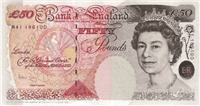 Obverse side of the 50 Pounds sterling is showing the portrait of Queen Elizabeth II. |
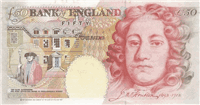 Reverse side of the 50 Pounds sterling is showing a portrait of Sir John Houblon. |
Useful links
- About Bank of England:
- Bank of England
- List of currencies:
- Currencies
- Security and design features of GBP banknotes:
- GBP banknotes
- GBP currency on Wikipedia:
- Pound sterling
- Official Website of Bank of England:
- www.bankofengland.co.uk
- Commemorative coins:
- Commemorative Coins